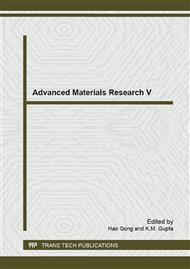p.141
p.149
p.154
p.159
p.164
p.172
p.178
p.182
p.190
Grinding of Austempered Ductile Iron Grade 3 as Function of the Microcrystalline Al2O3 Grinding Wheels Composition
Abstract:
The conventional grinding wheels employment is an economically viable alternative on Austempered ductile iron (ADI) grinding. The machining of this iron is in most cases performed with superabrasive grinding wheels, requiring machine tools with higher costs. The ADI grinding with conventional grinding wheels can produce work results comparable to the superabrasive grinding wheels, followed by lower costs and flexibility in profile grinding, since these wheels can be easily re-profiled. The aim of this work is to verify the work results of grinding ADI Grade 3 employing conventional grinding wheels. The approach is based on the influence evaluation of different abrasive microcrystalline Al2O3 percentage in these tools on the force results and roughness values in the ADI grinding. The findings show a correlation between the grinding forces and the microcrystalline abrasive percentage of microcrystalline Al2O3, since lower forces were demanded for wheels with higher percentages. Regarding the surface parameters, there was a decrease in roughness values by employing less percentages. The originality of this research is reflected in the fact that it is the first time that the influence of the composition of conventional grinding wheels is investigated on ADI Grade 3 grinding. The results present in this research will contribute to the most appropriate conventional grinding wheel specification for the ADI Grade 3 grinding.
Info:
Periodical:
Pages:
164-171
Citation:
Online since:
May 2015
Authors:
Price:
Сopyright:
© 2015 Trans Tech Publications Ltd. All Rights Reserved
Share:
Citation:


